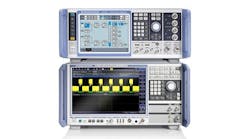Fifth-generation, or 5G, wireless technology is still in development. So how are you supposed to test devices using 5G signals?
On Monday, Rohde & Schwarz said that its test equipment is capable of generating and analyzing 5G signals based on a trial specification published by Verizon.
In July, Verizon released a specification that defines the physical layer characteristics of 5G signals. The specification was derived from the Long-Term Evolution, or LTE, standard. It operates at 28 GHz and 39 GHz, both of which the Federal Communications Commission recently set aside for 5G communications. Verizon’s proprietary signals is based on the OFDM waveform with a subcarrier spacing of 75 kHz and aggregation for up eight carriers.
Rohde & Schwarz said that one of its signal generators and one of its signal analyzers were capable of supporting the trial specification. The SMW200A is a vector signal generator that, when equipped with the special software, can configure OFDM signals with 75 kHz spacing and 100 MHz bandwidth. It can also set modulation schemes, including QPSK, 16 QAM, 64 QAM, and even 256QAM.
Rohde & Schwarz’s FSW signal and spectrum analyzer is also capable of measuring 5G signals from things like power amplifiers operating over high frequency bands. When measuring a 5G signal at 28 GHz, the measurement results from the analyzer were under 1% across a 10 dB power sweep.
Rohde & Schwarz will demonstrate its test equipment this week in Boston at the Electronic Design Innovation Conference, also known as EDI CON.

